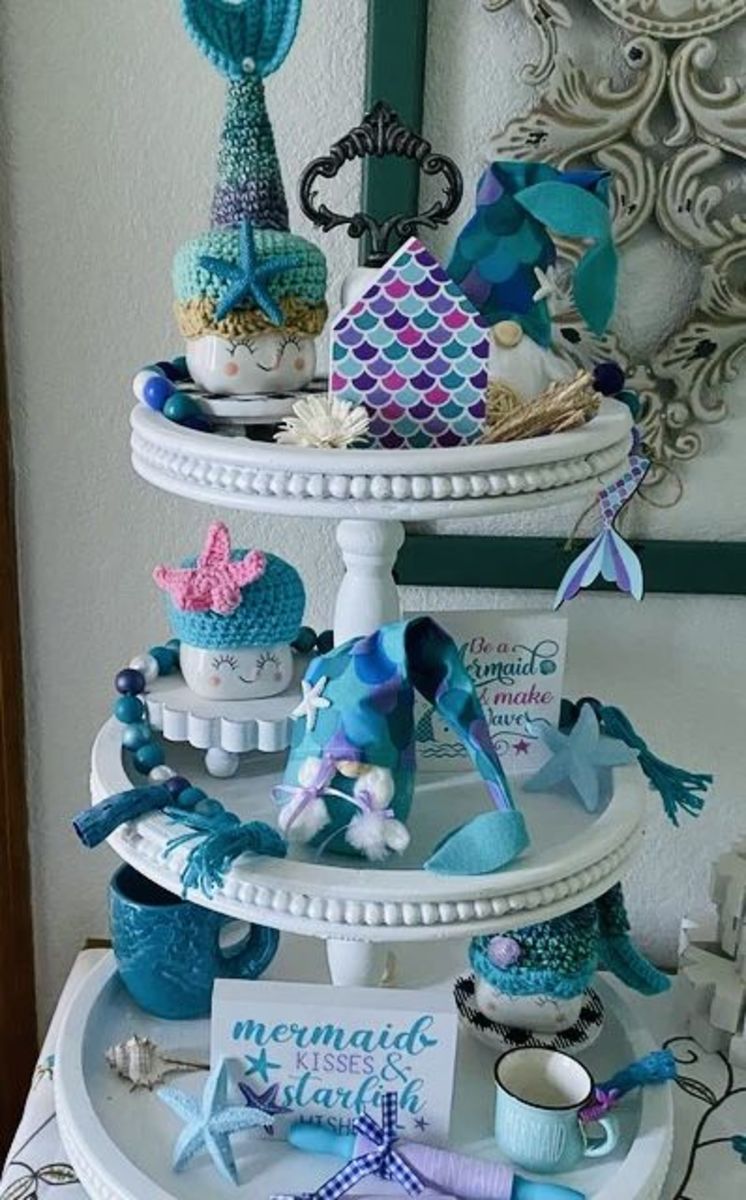Decorative & Scenic Painting
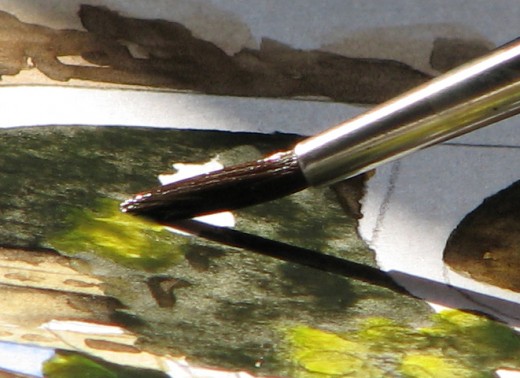
Paint Techniques for Home and Theater
If you're looking to add interest or drama to the walls of your home, there are simple painting techniques from the theater and stage that can work wonderfully well at your house.
Fun and easy painting!
Just pick out a wall, and let's get started.
(FYI This page has recently transferred from Squidoo to Hubpages - I'm still getting the kinks out!)
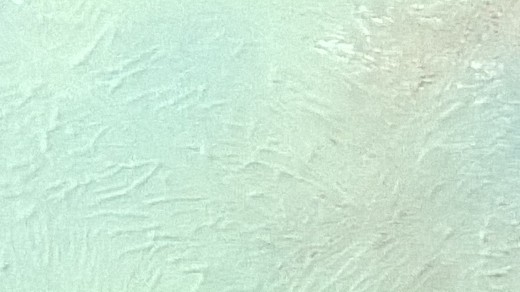
EQUIPMENT
Paint roller with cover(s) - rougher the wall, deeper the pile
Paint roller tray
Roller pole - wood screw-in type or extension for tall walls
Brushes - 2-3" standard or sash brush + 1" sash
Paints - 3-4 shades, latex (see notes under "Color")
Paint stir sticks
Paint can opener
Small hand-held containers
Water bucket(s)
Cotton rags
Sturdy ladder or step-stool
Painter's or masking tape
Painter's drop cloth(s)
OPTIONAL
Glaze - clear, low gloss
Screwdriver (to remove stuff)
Pliers (ditto)
An historic 1700s color wheel by Moses Harris
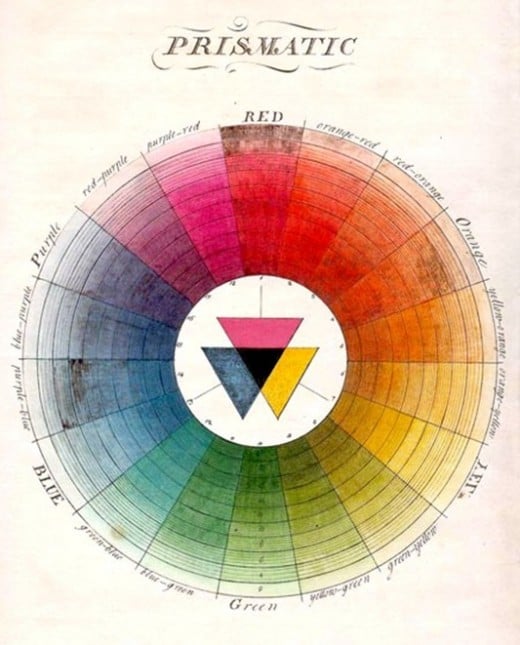
Scumbling Basics
A Simple Idea:
It's very simple: take three (that's classic) different shades of related colors and smoosh them together with a paint brush.
That's it.
Now, there's a lot of variation in exactly how you do this, so even if you're experienced, you'll want to practice before going wild on your wall. Take your time. DO NOT attempt this for the first time on your dining room wall the day before important company arrives for dinner! Having said that, this is an easy, fun technique which inexperienced painters can do quickly and successfully. It's just a matter of playing with the few variables, until you like the look.
The variables are:
- WALL SURFACE - what you're starting with makes a huge difference.
- COLORS - the difference between colors and how many colors you choose to use.
- BRUSH STROKES - how you "smoosh," whether fewer, bigger stokes or more, smaller ones.
- PAINTING TOOL - usually a brush, but which size effects your brush strokes. Obviously.
Paint Specification
The scumbling technique works with any paint that stays moist long enough to work one color into another.
(In traditional oil painting technique - for a portrait - paint should be rather dry, to get a coarse scumble effect. But even a large canvas is smaller than most small walls and the oil painter uses a smaller brush. So, for a wall, you'll probably want a big brush and wetter paint.)
For home use (and for many theaters) a water-based latex paint has real advantages: latex is readily available at any home building supply, hardware, or paint store; it's available in a range of prices and qualities to fit most budgets; it's durable; it comes in many, many colors; and, because it is water-based, clean up is soap-and-water simple. Take a serious look at the low VOC paints, which off-gas much fewer fumes and are less toxic than standard paints. Unless you can paint your wall and come back days later, the lack of smell and harmful fumes makes the extra cost worthwhile.
Color Choices
You can scumble using any colors you like. As a beginner, however, I'd suggest going subtle and using three closely related colors.
For instance, if you want the popular look of antique Italian stucco - let's say you want that golden brown that's almost mustard color. First pick exactly that preferred color ( the one you want, minus shading variations). Next choose a similar color that is a) darker by about two steps on those handy-dandy paint chip cards and maybe b) a bit less brightly colored, duller, or (we're talking aged stucco here!) closer to dirt color. This darker shade will be your base-paint color. (For "aged" effects, it's better to have a darker "dirtier" base so that the wall's cracks, seams, corners, and wherever your brush misses later, will look realistically darker.) To this dark base color and your favorite color add 1-2 others to scumble in: one of these colors should be a lighter shade of your favorite, the other should be a little "off" your favorite color and a bit livelier... For this mustard-y stucco effect it might be a purer yellow or a terracotta color.
A Note on Base Color: Even though, by the time you're finished, there may be little of that first color you put on the wall actually showing, it has a big effect on the final look. A dark base color adds a sort of heaviness to the final look, subduing the lighter top colors even if they are not transparent like glazes and a light base color causes the top layers to glow. (This is why primer paint intended for light top coats is usually white - max. glow! - and for saturated darker top coats, the primer is often tinted too - for max. depth. I know one fine art painter who often primes her canvases with day-glo orange and lets this peek through here and there to add a sun-kissed look to her final paintings.
As you gain confidence you can make your color choices less subtle, but keep in mind that all the colors you choose must look pleasing together. It's worthwhile to get small amounts of the paints early on - during the "playing" period - so you can experiment. Don't get chicken! Some surprising combinations look great together. For instance, watery blues and greens look terrific with an unexpected touch of purple (and I'm not a purple person either).
Generally, as a rule of thumb, successful scumbling colors tend to come from the same quarter of the color wheel. Colors opposite to each other on the color wheel tend to cancel each other out when evenly mixed together - orange and blue, for instance - but when put side by side, they have maximum zing! Before painting on your real-world wall, you need to know how lively or how harmonious an effect you want to create. This is one of the reasons for a practice period first.
My Favorite Scumbling Brush
This is the handiest brush I know for decorative painting.
A good brush is important because it has more resilience and a nicer, smoother action than a very cheap or disposable one. I like a sash brush like this one, with its angled shape, because it helps make my strokes fluid and natural. I tend to scumble at an angle of about 45 degrees (which looks looser and more casual than up-n-down or side-to-side brush strokes). This brush is perfect!
Perfect Decorative Painting Brush

STEP 1 - Preparation
There are two stages to preparation: the first is fun, playing with paint ahead of time; the second is the usual boring prep required for any painting project - cleaning, masking and draping adjacent areas you don't want painted.
PLAYING:
Take your time and enjoy yourself. Start on a pile of scrap cardboard or plywood a day or two ahead, just playing around, until your scumbling feels comfortable and looks about how you want it. To do this, paint your scrap background your base color, color #1 (we'll talk about color selection later) and let it dry. Later, come back with 2-3 other colors.
You'll want to be relaxed but quick. With your brush (more on that later) take a good slop of color #2 and make a big wet dab anywhere. Do the same for color #3, placing that dab about 9" away from the first. Repeat with color #4. (Color #4 might be more of your base color.) Now you have a triangle of paint-y dots. While the paint is wet, take your brush and go slap, slap, slap, brushing the three colors into each other. Add more paint as you need it.
Easy!
You'll find that some areas of your work you like, others not so much. Keep dabbing new paint dots on and smearing them together until you find which color looks nice brushed into which other and how. Experiment. Play. Have fun.
PAINTING PREP:
As with any painting project, it pays to spend time preparing. Tape off and drape with plastic or painter's brown paper all areas around your wall you DON'T want painted. Be diligent about covering (or removing) fabrics, carpet, or other surfaces paint might stain. Remove picture hooks and hardware from the wall if possible. Move away furniture etc. Dust the wall and, where needed, wash off any greasy areas, being careful not to leave soap film behind. Clear away furniture, lamps, art, etc. Give yourself some elbow room.
Remove or mask light switches or electrical outlet plates you don't want painted. (If you remove them, remember this is LIVE ELECTRICITY. Use caution, shut off power if possible, cover safely, and generally BE SAFE.)
Get as much light as you can - it's best to paint in daylight.
Once everything is ready in the room, prepare your painting gear. It's wise to set paint buckets in a tray or at least on plastic in case you dribble or spill. Set the colors together with a bucket of clean water next to them and your painting tools nearby. Have clean rags and clean water for fast cleanups. It's also smart to carry paint up a ladder in the smallest container you can - a plastic cup or recycled yogurt container works. This will be lighter and, if you drop it - - - it's a smaller splash!
The technique of scumbling depends on paint staying damp enough to blend easily, so dip your brush in the water bucket now and then to keep things fluid. Likewise, you might turn off your huge ceiling fan or dehumidifier (or air conditioner or radiator you're painting!) so the paint dries more slowly.
STEP 2 - Base Painting
If your wall is any size at all, you're going to want to use a paint roller to speed the first, base coat of paint. Cut in paint at edges and corner with a brush, roll the rest. Let dry.
OR
If you're going for an extra fast or an extra dramatic version of scumbling, you can start the process with your paint roller. While the base coat is damp, pour more of base color #1 into the roller tray, then pour in some color #2, 3, or 4. Let these mix on the wall as you roll. This will obviously look crude, but you can soften it with brushwork later. When doing a very large wall (like on-stage), several walls, or in a huge hurry, this speeds things up amazingly.
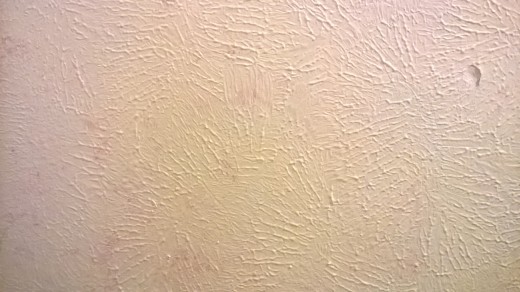
STEP 3 - Scumbling
Once the base coat of paint is dry - - - Well, it needn't be dry, but by now you're ready for a little break. After your break or next day, start the three-splotches-of-paint-and-smoosh technique you practiced earlier.
Start at an out-of-the-way lower corner and work your way up that wall edge. You can skip around if you like. But it's easier to blend smoothly at a wet edge, so you'll find yourself adding wet paint on top of already dry paint - that's okay. You'll want to do the most visible areas of the wall when you're feeling happiest and the less prominent parts either early on (as you're loosening up) or late (as you tire).
As you scumble, keep stepping back to judge your work. Is it too blotchy here? Too smoothly blended there? Walls often look best if there is a gradation from darker near the floor, ceiling, and corners, to somewhat lighter toward the center of the wall. (Darker toward the top is standard on stage, because it draws the audience's eyes toward the actors. Doesn't that make sense in a dining room too?) Turn on some music - it helps the rhythm of your work. Rowdy music speeds you up!
STEP 3 1/2 - Alternate Scumbling
If you want a wall with a softer, more transparent, more jewel-like look, you probably want to mix your scumbling paints (not your base paint) with glaze. Ask your paint supplier for a clear un-tinted glaze medium. This milky-looking goo dries clear but slightly shiny, so you'll want all your paints to have a slight sheen too - buy eggshell, satin, or perhaps semi-gloss for extra shine.
The Glaze medium can will tell you to mix it about 1/2 and 1/2 with your paints, but, as glaze is expensive, I prefer to just dip my brush in it as I would in water to modify the paint's consistency. When the mix on the wall starts looking dull and too opaque, add a little glaze to make it more translucent.
Scumbling Demonstrations
FIRST VIDEO - by Total Theater - Watch a scenic artist paint a sky backdrop to get the idea. This painter is working horizontally, not vertically, but the brush action is the same. The look is probably bolder than you'd want at home. Also look at the SIZE of this canvas being painted - fast! - by one person.
SECOND VIDEO - by Vesalux - Watch a fine art painter scumble a vertical canvas. Same idea, but much more painstaking (and slow) than you'd care to do for a whole wall, though it gives a nice idea of the complex color possible. Towards the end the artist also scratches and then rags (to soften) this painted surface. All cool techniques!
If You're Designing a Theater Set
Read this Book
A useful how-to guide to the art and business of theater set design - with extensive chapters on the design process, from first reading the script through final strike.
With humor and wide experience, this book explains the strange world of theater (and a bit of TV/film) from a designer's view, with step-by-step explanations of the design process, from the first production meeting, right through Opening Night to Strike:
---- Reading the play
---- Designing - research, design methods and elements
---- Documenting that design through drawing and modeling
---- Building, painting, furnishing, and dressing a set
Alice also includes: a fast illustrated romp through style history; lists of helpful tools, materials, and books
Click on the cover to visit sample pages.
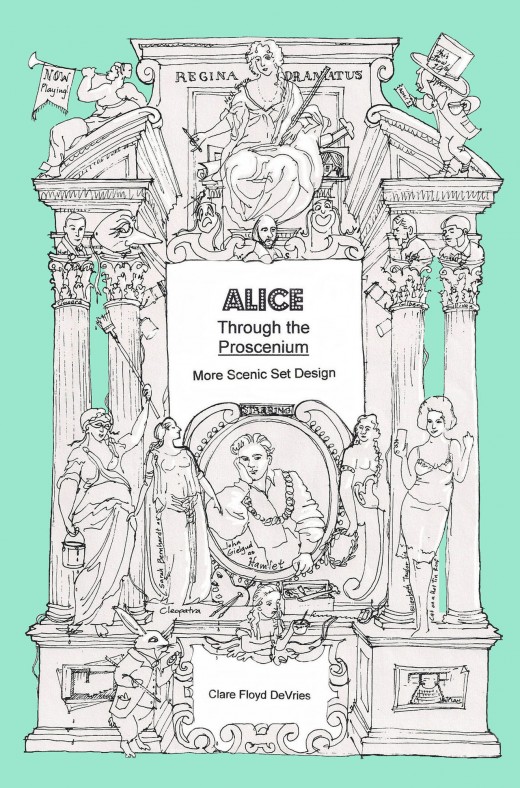
© 2011 cdevries



